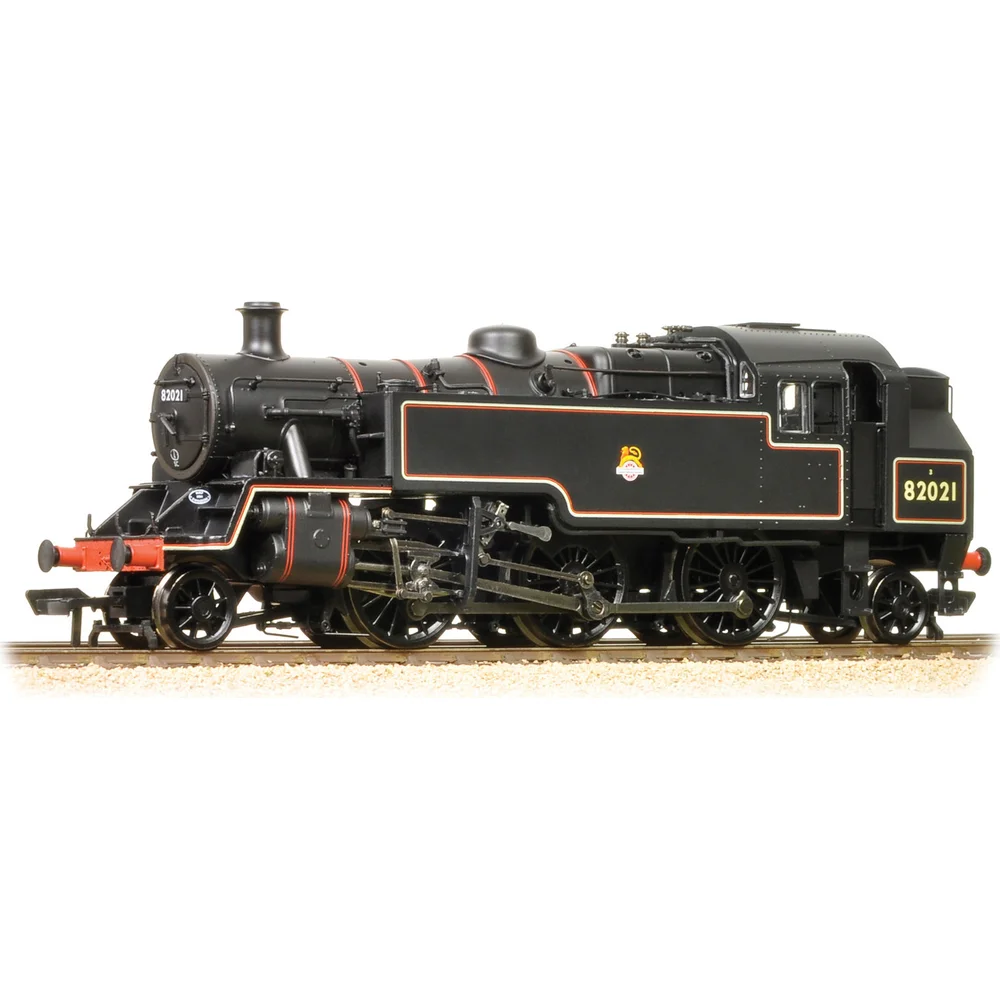Bachmann 31-981
British Railways Standard 3 2-6-2T 82021 British Railways Lined Black with Early Emblem
Tooling
Bachmann introduced its OO gauge model of the BR Standard Class 3MT 2-6-2T in 2009 as part of the Branchline range. The prototype was a versatile mixed-traffic tank engine designed by R.A. Riddles in the early 1950s, combining LMS and GWR design elements. Bachmann’s tooling aimed to capture this hybrid character with high fidelity and modern features for the time.
Tooling Features
- Scale: OO gauge (1:76), 2-rail DC operation.
- Construction: Plastic bodyshell with separately fitted details including handrails, lamp irons, pipework, safety valve, whistle, and smokebox door dart.
- Detailing: Chemically blackened wheels, fluted connecting rods, brake rigging, sanding gear, and a detailed cab interior with painted controls and glazing.
- Couplings: NEM pockets with tension-lock couplers; sprung metal buffers.
- Working Features: Opening smokebox door and roof vent; accessory pack with vacuum pipes, fire irons, and bufferbeam detail.
Mechanical & Electrical
- Motor: 3-pole motor mounted in the chassis.
- Drive: Loco-driven wheels with pickups on driving and leading wheels.
- Minimum Radius: Second radius curves (approx. 18 inches).
- Weighting: Balanced for smooth running; recommended running-in period of 1 hour each direction.
- Lighting: No factory lighting provision.
DCC Capability
DCC Ready with an 8-pin NMRA/NEM socket located in the chassis. No factory sound provision, but space for aftermarket speaker installation.
Liveries Produced
The tooling has been released in BR lined black (early and late crest), BR lined green (early and late crest), and weathered finishes. These reflect the prototype’s service life from the 1950s through the early 1960s.
Reviews & Commentary
Upon release, the model was praised for its accurate proportions, fine detailing, and smooth running. Reviewers highlighted the realistic finish on motion gear and the comprehensive accessory pack. Some early feedback noted limited space for sound installations, but overall reception was positive, positioning it as a strong addition to Bachmann’s standard range.
Media & Social Media
Model railway forums and YouTube reviews from 2009 onward consistently commended the tooling for its fidelity and reliability. Enthusiasts appreciated the opening smokebox door and cab detailing, often citing it as a benchmark for mid-sized tank engines of the era.
Interesting Notes
The prototype’s design heritage—combining LMS Ivatt chassis principles with a GWR-inspired boiler—was faithfully represented in the model. This attention to historical detail contributed to its popularity among collectors and operators alike.
Class & Prototype
- Class: British Railways Standard 3 2-6-2T
- Traction: Steam
- Built: 1952-1955
- Total Built: 45
- Running Number: 82021
- Name: -
- Ordered By: British Railways
- Built By: British Railways
- Built At: Swindon
- Built: 10/1954
- Withdrawn: 10/1965
- Length of Service: 11.0 years
- Running Numbers: BR 82021
- Names: -
Operator & Livery
- Operator: British Railways
- Livery: Lined Black with Early Emblem
British Railways transformed Britain's fragmented rail network into a unified national system following nationalisation on 1st January 1948. Created from the "Big Four" companies under the Transport Act 1947, BR operated most of Great Britain's railways until rebranding as British Rail in 1965, managing over 20,000 route miles and inheriting nearly 20,000 locomotives of diverse designs.
The organisation pioneered standardisation through its revolutionary BR Standard locomotive programme (1951-1960), producing 999 advanced steam engines under Robert Riddles' direction. These included the versatile Britannia Pacifics, mighty 9F freight engines, and mixed-traffic classes that incorporated the best features from all predecessor companies. The 1955 Modernisation Plan accelerated diesel and electric traction development, creating fascinating mixed-traction operations.
Notable achievements included establishing unified locomotive classification systems, introducing distinctive corporate liveries, and managing the complex transition from steam to modern traction. BR's six regional structure preserved operational diversity whilst enabling standardisation of practices, signalling, and rolling stock that had eluded private enterprise for over a century.
The BR era represents steam traction's final flowering alongside emerging diesel technology, creating unparalleled locomotive variety. Today, this heritage remains highly popular with railway enthusiasts through extensive preserved fleets, heritage railway operations, and comprehensive model ranges from manufacturers like Hornby, Bachmann, and Dapol, making BR subjects essential for authentic post-war British railway modelling across all scales.
British Railways' lined black livery was designated for mixed-traffic and secondary passenger locomotives from 1949, following pure LNWR style with black base colour and elaborate red, cream (off-white), and grey lining patterns. The lining specification comprised 5/8" grey, 1/8" cream, 1½" black, and ¼" red bands, with the layout consistent with LNWR practice including deep and shallow valances lined along bottom edges only, unlike green engines. The first lined black engines appeared in August 1948 when Hall 5954 appeared so painted, becoming one of the first to carry the "Lion and Wheel" emblem around the same time.
A wide range of engines was eligible for this livery, from powerful V2s and Counties down to tiny Southern Terriers, encompassing County, Hall, Grange, Manor, Saint, Prairie tanks, and numerous pre-grouping designs of varied shapes and sizes. This created many variations and interpretation problems due to the diverse locomotive types involved, with regional differences in splasher lining treatment—the Eastern Region used red-only splasher lining, whilst the Southern Region evolved from inset to edge lining styles. The emblem was positioned centrally on tender sides above the middle axle box, with the Western Region favouring larger sizes on tenders and bigger tank engines. An interesting period detail saw number plates routinely painted red from late 1949 to early 1952, adding colour contrast to the otherwise black scheme. This livery represented BR's commitment to standardising mixed-traffic operations whilst maintaining the decorative traditions that distinguished passenger-rated locomotives from plain freight engines.
